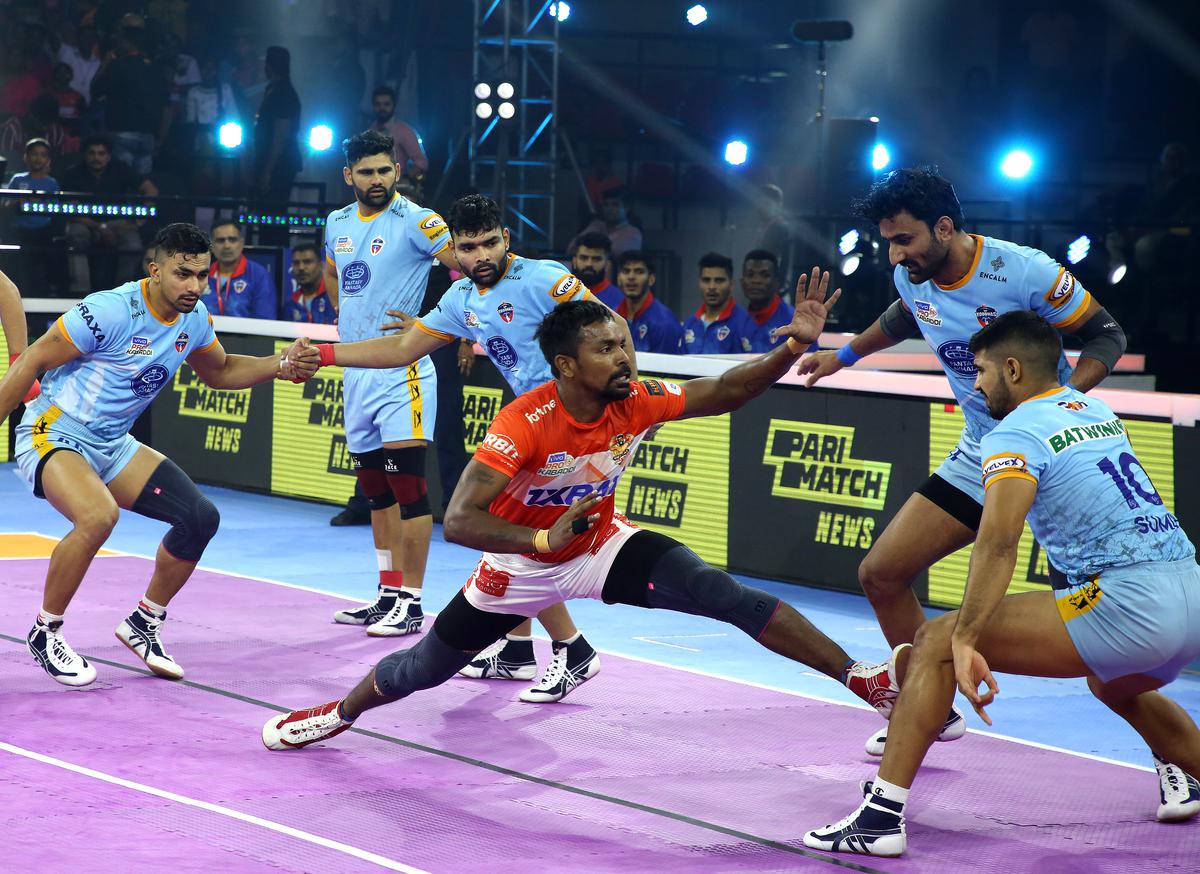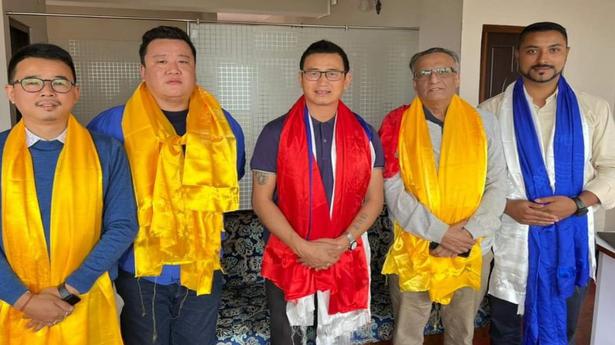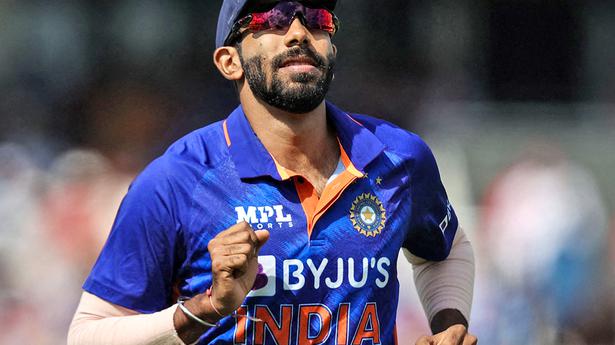A crowd of about 100 people restlessly wait in front of Sree Kanteerava Indoor Stadium in Bengaluru. It is a Wednesday evening, and they are in line to watch a Pro Kabbadi double header — Gujarat Giants versus UP Yoddhas and Bengaluru Bulls versus Tamil Thalaivas.
An announcement from a loudspeaker instructs people to display the ticket on their email or the ticket-booking app and not a screenshot. Some begin to scour through their phones. A family of four – a middle-aged couple, an elderly woman, and a kid – clad in red-and-black Bengaluru Bulls jerseys await their turn to enter the gate. Pro Kabaddi has been their dinner routine for the last three years.
“We don’t even watch cricket as much as we watch kabaddi,” says Sharadha D, a bank employee. “Yeah, there is just too much cricket these days,” the father, Krishnaraja, chimes in (The auditorium, however, would later scream, rather absurdly, the name of the local IPL team — “RCB, RCB” — whenever Bengaluru Bulls score a point). As the kid starts talking about his interest in Pro Kabaddi, team buses enter the premises, one after another. He frantically waves his hands at the bus windows, yelling the names of his favourite players, hoping to get a wave in return. One of the names is Chandran Ranjit, the captain of Gujarat Giants.
RANCHI, JHARKHAND, 21/09/2017: Nitin Rawal raiding for Jaipur Pink Panthers against Haryana Steelers in the Vivo Pro Kabaddi League (season five) at Harivansh Tana Bhagat Indoor Stadium in Ranchi on September 21, 2017.
Photo: Manob Chowdhury
| Photo Credit: MANOB CHOWDHURY
Chandran is from Alathankarai, a hamlet in Kanyakumari and one of the many scattered kabaddi hubs in Tamil Nadu. The Alathankarai Kabaddi Club, founded in 1989, has produced several national and international players. Chandran has been playing kabaddi since he was 15. His coach initially told him he was too thin to play the sport; he suggested volleyball instead. But whenever the coach wasn’t looking, Chandran joined a kabaddi game. “I just wanted to play the sport,” he says. “I never thought if it would help me get employed; if it would help me to support my family; if it would get me somewhere in life.” But it did — he built a house for his parents; married off his sister; and from being relatively unknown in Alathankarai, he now has fans in Bengaluru yelling his name.
Pro Kabaddi, started in 2014 (as Pro Kabaddi League), changed Chandran’s life — and the sport itself.
A brief history of kabaddi
Kabaddi is said to have existed in the subcontinent in one form or the other since prehistoric times. There are apocryphal tales of Krishna and, later, Buddha playing the ancient form of the sport. Rononjoy Sen’s book, Nation At Play, speculates it originated during the Vedic Age (between 1500 BC and 600 BC). According to the Amateur Kabaddi Federation of India (AKFI), which is the National Sports Federation of kabaddi, the first framework of rules for the sport was prepared in Maharashtra in the 1920s. One of the earliest tournaments of modern kabaddi, the All India Kabaddi Tournament in 1923, was played according to these amended rules. A little-known physical education institute from Amravati, Maharashtra, showcased the sport at the 1936 Berlin Olympics (though it was not officially a part of the event). This was the sport’s first major international appearance. Kabaddi gradually grew in the latter half of the 20th Century. In 1990, it was a part of the Asian Games, wherein India won the inaugural gold medal. It went on to win the gold in each of the next six editions. India was the undisputed kabaddi champ.
Glamourising the game
Despite being so good at it, India did not have a big following for kabaddi. It was considered a rural sport. The buzz for the sport came only once in four years when the men’s team (and later the women’s team) won the gold medal at the Asian Games.
During the Asian Games in Guangzhou in 2010, Deoraj Chaturvedi, an official from the Asian Kabaddi Federation, met commentator Charu Sharma to discuss the idea of a professional league for kabaddi. Only two years ago, the Indian Premier League was launched and was a smashing hit. The duo felt a league for kabaddi would work too.
Four years later, Mashal Sports, a company founded in 1994 by Sharma and industrialist Anand Mahindra , along with Disney Star launched the Pro Kabaddi League. It glamourised the game with brightly coloured mats, laser lights, DJs, and film stars (some of them who owned teams).
“We knew there was a cultural cognisance of the sport in India. For instance, you can easily recall popular films where the hero is a kabaddi player. We needed to resonate with this following and reform the sport,” says Anupam Goswami, executive head of Mashal Sports and the League Commissioner of Pro Kabaddi.
It was not just the external embellishments. The league, Anupam adds, invested heavily in sports science and analytics to ensure the highest standard of competition and broadcasting. “The players have access to the best coaches, conditioning, and injury management. We got overseas players. We made sure that one team did not dominate the league — the talent was equally split. All this ensured that the people who turn up at the stadiums witnessed the highest quality of the sport,” he says. “Those watching it on their screens have access to some insightful numbers you wouldn’t get anywhere else.”
Pro Kabaddi made a hinterland sport a cynosure of primetime television.
Fans at Pro Kabaddi
| Photo Credit: Special Arrangement
Rapid growth
After the IPL, Pro Kabaddi is the most-watched sports league in India, which also has Indian Super League (football), Premier Badminton League, among others. In its inaugural season in 2014, 435 million people watched the 37-day event (the same year, IPL had 552 million viewers). Pro Kabaddi also has the most participants (12) among all sporting leagues in the country.
The value of the league seems to have soared as well. For instance, the highest bid during the player auction increased from Rs 12.8 lakh (for Rakesh Kumar by the Patna franchise) in 2014 to ₹2.26 crore (for Pawan Kumar Sherawat by Tamil Thalaivas) in 2022. To put that in perspective, the total prize money in season four (₹2 crore) was lesser than what Pawan got this year. Another indicator of the league’s enormous growth is its media rights value. Last year, Star India purchased the rights till 2025 for ₹905 crore. Team owners, who were unhappy with the auction process, believed the league could have generated a higher broadcast revenue.
Star India’s all-guns-blazing marketing worked wonderfully. In rural centres and urban, scores of people tune in to the league. Jaipur Pink Panthers’ Ajith Kumar says his entire neighbourhood in his village, Samipillaipudur (in Karur district of Tamil Nadu), switch from TV soaps to Pro Kabaddi when the league is on. The league seems to have spread across different age groups and genders. Keerthana C, an aspiring kabaddi player in Bengaluru, says she never misses any of Bengaluru Bulls’ matches. Though kabaddi has traditionally been a male-dominated sport, there’s a growing interest among women as well. The national women’s team, for instance, won two gold medals and a silver medal in the last three Asian Games.
One of the reasons for Pro Kabaddi’s success, at least on TV, is the brevity of the sport. The whole deal, from the toss to the presentation, gets over within an hour — which is less than a T20 game. The matches begin late evening a convenient time for the entire household to watch.
Despite these impressive numbers, the league is still in its infancy. The organisers are still experimenting with its rules, format, and scheduling. They have to tackle the task of increasing public interest in the sport. “We need to keep updating ourselves with game-changing technologies, say, with respect to refereeing. We need to discover young talent and nurture them,” says Anupam. “Hopefully, the league’s success will translate into medals for India in the Asian Games and other international events. We have just started. There is a long way to go.”





